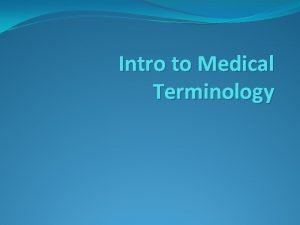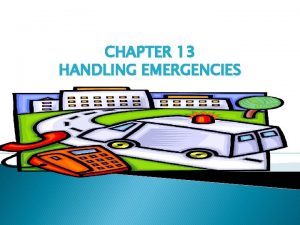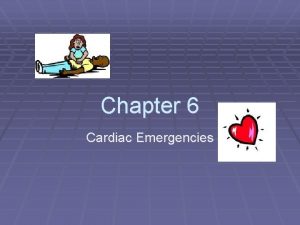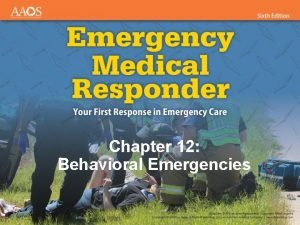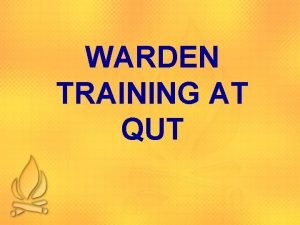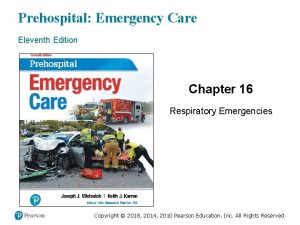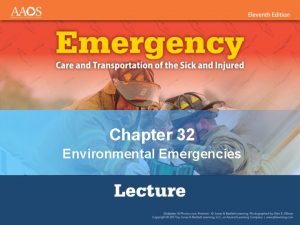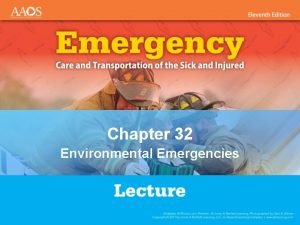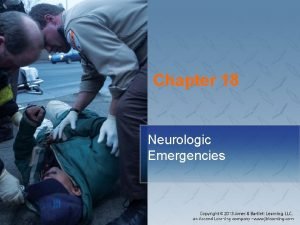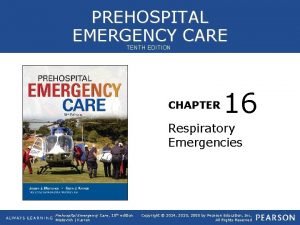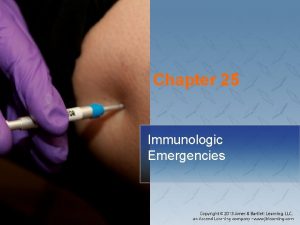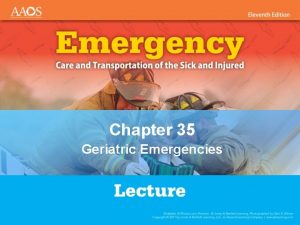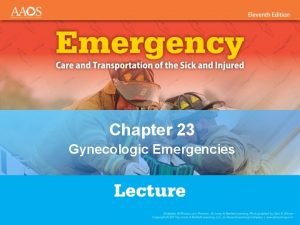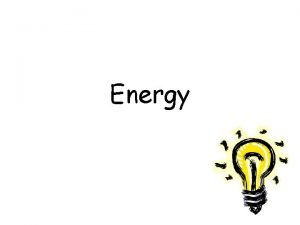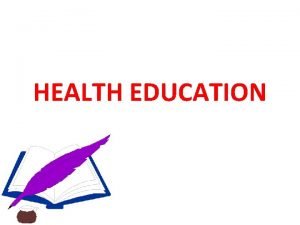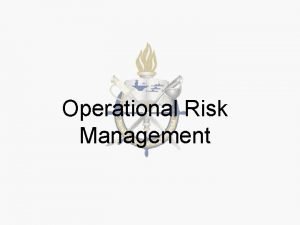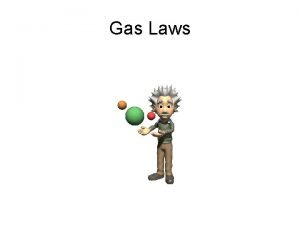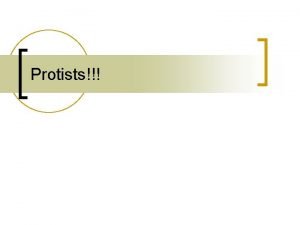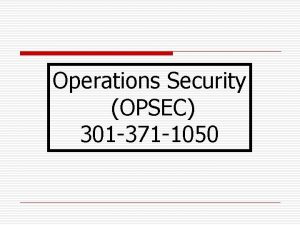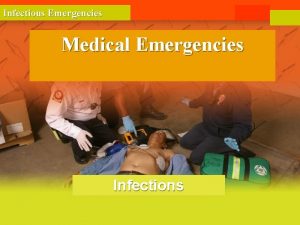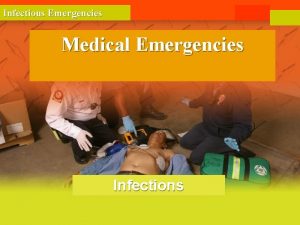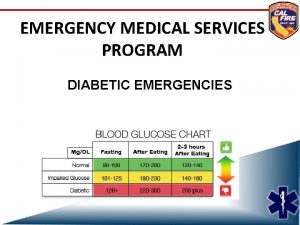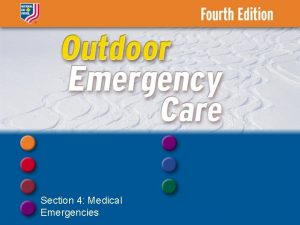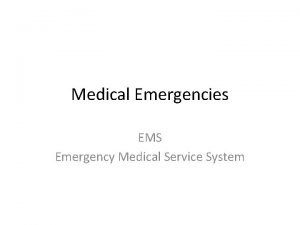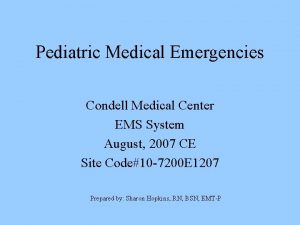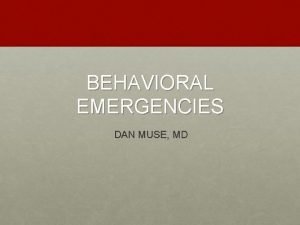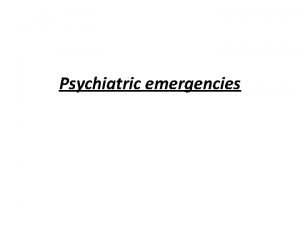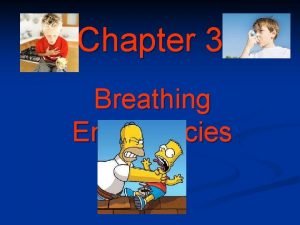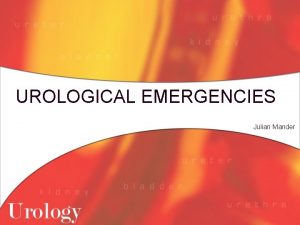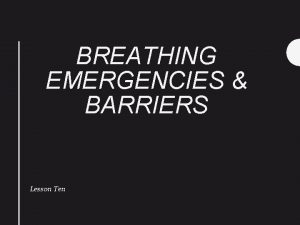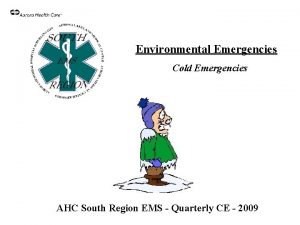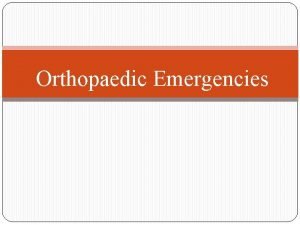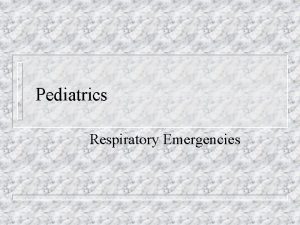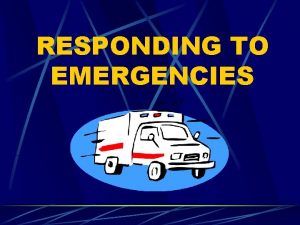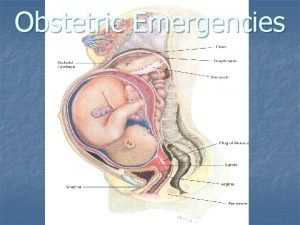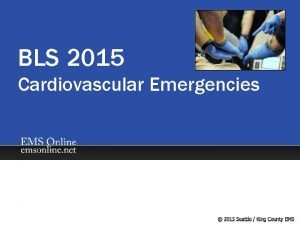MEDICAL EMERGENCIES Medical Emergencies Defined n A situation












































- Slides: 44

MEDICAL EMERGENCIES

Medical Emergencies Defined n A situation in which the condition of the patient or sudden change in medical status requires immediate action n n n Head Injuries Shock Diabetes Respiratory distress Cardiac arrest Cerebral vascular accident

The Radiologic Technologist Role n n Preserve life Avoiding further harm Obtaining further medical assistance Knowing when assistance is warranted (most important)

General Priorities n n n Ensure an open airway Control bleeding Take measures to prevent or treat shock Attend to wounds or fractures Provide emotional support Continually re-evaluate and follow-up appropriately

Emergency Cart n Know location and contents

HEAD INJURIES n It is not the radiology technologist responsibility to diagnose, but it is useful to have basic knowledge for assessment purposes

LEVELS OF CONSCIOUSNESS n Alert and conscious n n More serious n n Drowsy, but can be roused Even more serious n n Responds fully does not respond to verbal commands, but can react to painful stimuli Most Serious n Unresponsive or comatose

Indications of Deteriorating Conditions n n Irritability Lethargy Slowing pulse rate Slowing respiratory rate

Responses to Deteriorating Situations n n Stop the procedure Make sure there is an open airway Obtain assistance Obtain vital signs while waiting

The Intoxicated Patient Inebriated vs. head injury

SHOCK Failure of the circulatory system to support vital body functions

Definition and Types n n Hypovolemic – due to loss of blood or tissue fluid Cardiogenic – due to a variety of cardiac disorders, including myocardial infarction Neurogenic – due to spinal anesthesia or damage to the upper spinal cord Vasogenic – due to sepsis, deep anesthesia, or anaphylaxis

Prevention n Maintain body temperature Avoid pain, if possible Minimize stress and anxiety

Signs and Symptoms n n n n Restlessness Apprehension General anxiety Tachycardia Decreasing blood pressure Cold and clammy skin Pallor

Contrast Media Reactions (Anaphylactic Shock) n n Any medication can be harmful if not administered properly Moderate to severe n n As a general rule, the longer it takes for a reaction to develop, the less severe it is Typically most severe reactions arise immediately

Anaphylactoid reactions Allergic-like effects n n Thought to be caused by the release of histamine Mild n n Moderate n n Warm sensation, metallic taste, sneezing Nausea, vomiting, itching Severe n Respiratory or cardiac crisis





Responses to Deteriorating Situations n n Stop the procedure Make sure there is an open airway Obtain assistance Obtain vital signs while waiting

n n The role of the radiology technologist should be established in the procedures in each facility. Very important to document condition of patient before and after event

n INFILTRATION or EXTRAVASATION: contrast or medication enters soft tissue instead of vein Signs: swelling, pain, burning, redness Cause: needle displacement n STOP EXAM IMMEDIATELY n n Apply ice if <30 min Apply warm, wet compression of >30 min

THE DIABETIC PATIENT n n NPO prep may create problem If patient takes insulin without food, insulin production and excretion may be altered due to lack of carbohydrates n adjustment must be made immediately

Hypoglycemia n A condition in which excessive insulin is present n Taking insulin without food n Depletes body’s energy and quickly leads to insulin shock Symptoms include: hungry, weak, shaky, confused, sweaty, irritable

Hypoglycemia (con’t) n Solution: Carbohydrates n n n Glucose tablets Orange juice sweetened w/sugar A sugared soft drink Candy bar, etc. No food or drink should be given to an unconscious patient

Hyperglycemia The condition of excessive sugar in the blood and is the characteristic typically associated with diabetes. n Symptoms: n n Excessive thirst and urination Dry mucosa Rapid and deep breathing Drowsiness and confusion

Hyperglycemia (con’t) n Solution: Patient needs insulin

RESPIRATORY DISTRESS AND RESPIRATORY ARREST § The Asthma Patient § § § Anxiety and stress of having the exam may cause reaction The technologist role is to keep calm, as this will calm the patient Allow patient to sit and determine if medical assistance is needed

n The Choking Patient n Evaluate the situation n n “Can you speak? ” Clutching throat Turning red in the face Encourage patient to cough Use Heimlich maneuver if necessary

CARDIAC ARREST n Signs and Symptoms n Crushing chest pain that may or may not radiate down the left arm

CPR (Cardiopulmonary Resuscitation) n n Alert the proper personnel before beginning Cerebral function is generally impaired if the brain is deprived of oxygen for more than 4 to 6 minutes

3 Primary Aspects of CPR n 1. 2. 3. ABC’s Airway Breathing Circulatio n

Considerations n DNR request Once begun, basic life support should (and for legal reasons, must) be continued until the victim resumes spontaneous respiration and circulation, a physician or other responsible health care professional calls a halt, or the rescuer is too exhausted to continue.

Cerebrovascular Accident n Stroke n Onset could be sudden or gradual n n n Paralysis Slurred speech Dizziness Vission loss Loss of consciousness

Minor Medical Emergencies n n n Nausea and vomiting Epistaxis Vertigo and syncope Seizures Falls

Nausea and Vomiting n n Breath slowly and deeply Turn head to side and give patient emesis basin


Epistaxis n Defined: nosebleed n n Lean forward, pinch nostril (do not lean back) If not effective within 15 minutes, get help

Vertigo and Syncope n Vertigo: dizziness n n Allow patient to sit or lie down Syncope: fainting n n Temporary lack of blood flow to brain Allow patient to lie down with feet elevated, loosen clothing

Seizures n Mild to severe n n n Slight confusion or weakness, body trembling and drooling Exam should be postponed Protect patient with pillows, clear airway and summon help

Falls n Attempt should be made to minimize impact when possible and then proceed to get assistance

Wounds n n n Hemorrhage: note condition, if bleeding, apply pressure; if extremity, place above heart if possible Burns: maintain sterile precautions, be extra gentle with patient Wound dehiscence: uncommon; a patients sutures come apart and abdominal contents spill out

SUMMARY Be alert and aware that emergencies do happen in the radiology department. Respond in a calm and confident manner.
 It is collection of well defined objects
It is collection of well defined objects Medical terms built from word parts are defined by
Medical terms built from word parts are defined by Chapter 16 cardiovascular emergencies
Chapter 16 cardiovascular emergencies Emt chapter 18 gastrointestinal and urologic emergencies
Emt chapter 18 gastrointestinal and urologic emergencies Major nutritional deficiency diseases in emergencies
Major nutritional deficiency diseases in emergencies Chapter 17 neurologic emergencies
Chapter 17 neurologic emergencies Chapter 13 handling emergencies
Chapter 13 handling emergencies The term behavioral crisis is most accurately defined as
The term behavioral crisis is most accurately defined as Psychiatric emergencies
Psychiatric emergencies Chapter 28 lesson 1
Chapter 28 lesson 1 Lesson 6: cardiac emergencies and using an aed
Lesson 6: cardiac emergencies and using an aed Chapter 12 behavioral emergencies
Chapter 12 behavioral emergencies Chapter 19 endocrine and hematologic emergencies
Chapter 19 endocrine and hematologic emergencies Qut security emergency extension number
Qut security emergency extension number Besides being required for diver training
Besides being required for diver training Chapter 16 respiratory emergencies
Chapter 16 respiratory emergencies Environmental emergencies emt
Environmental emergencies emt Chapter 32 environmental emergencies
Chapter 32 environmental emergencies Chapter 18 neurologic emergencies
Chapter 18 neurologic emergencies Chapter 16 respiratory emergencies
Chapter 16 respiratory emergencies Immunologic emergencies
Immunologic emergencies Gems diamond geriatric assessment
Gems diamond geriatric assessment Leukostasis symptoms
Leukostasis symptoms Chapter 23 gynecologic emergencies
Chapter 23 gynecologic emergencies Torrance memorial outpatient lab
Torrance memorial outpatient lab Ptal california medical board
Ptal california medical board Cartersville medical center medical records
Cartersville medical center medical records Gbmc medical records
Gbmc medical records Hepburn osteometric board
Hepburn osteometric board Missy diwater the former platform
Missy diwater the former platform Probability is defined as:
Probability is defined as: Circumferencce
Circumferencce Python event manager
Python event manager Health education defination
Health education defination Abcds of orm
Abcds of orm Politics can be defined as
Politics can be defined as Difference between psychoanalysis and psychodynamic
Difference between psychoanalysis and psychodynamic Poverty definitions
Poverty definitions How is gas pressure defined
How is gas pressure defined Light may be defined as
Light may be defined as Defined
Defined Payroll definition
Payroll definition Stoichiometry
Stoichiometry Opsec indicator is defined as
Opsec indicator is defined as Acceleration error constant formula
Acceleration error constant formula

